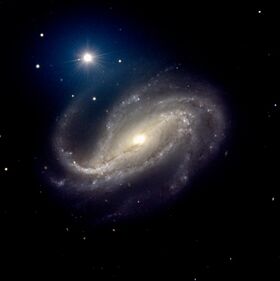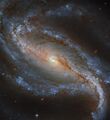Astronomy:NGC 613
| NGC 613 | |
|---|---|
 | |
| Observation data (J2000 epoch) | |
| Constellation | Sculptor |
| Right ascension | 01h 34m 18.235s[3] |
| Declination | –29° 25′ 06.56″[3] |
| Helio radial velocity | +1,487[4] |
| Distance | 67.5 Mly (20.7 Mpc)[5] |
| Apparent magnitude (V) | 10.0[6] |
| Characteristics | |
| Type | SBbc(rs)[7] |
| Apparent size (V) | 5′.2 × 2′.6[6] |
| Other designations | |
| MCG-05-04-044, PGC 5849[8] | |
NGC 613 is a barred spiral galaxy located 67 million light years away in the southern constellation of Sculptor.[5][9] This galaxy was discovered in 1798 by German-English astronomer William Herschel, then re-discovered and catalogued by Scottish astronomer James Dunlop. It was first photographed in 1912, which revealed the spiral form of the nebula.[6] During the twentieth century, radio telescope observations showed that a linear feature in the nucleus was a relatively strong source of radio emission.[10]
NGC 613 is inclined by an angle of 37° to the line of sight from the Earth along a position angle of 125°.[11] The morphological classification of NGC 613 is SBbc(rs),[7] indicating that it is a spiral galaxy with a bar across the nucleus (SB), a weak inner ring structure circling the bar (rs), and moderate to loosely wound spiral arms (bc).[12] The bar is relatively broad but irregular in profile with a position angle that varies from 115–124° and dust lanes located along the leading edges. Star formation is occurring at the ends of the bar and extending along the well-defined spiral arms. The central bulge is readily apparent, with a radius of 14″.[11]
The classification of the nucleus is of type HII, indicating a match to the spectrum of an H II region. Near the core, the stars have a velocity dispersion of 136 ± 20 km/s. The nucleus is a source of radio emission with the form of an inner ring with a radius of about 1,100 ly (350 pc) and a linear feature that is perhaps perpendicular to it. The latter consists of three discrete blobs spanning approximately 2,000 ly (600 pc).[13] Observations suggest the presence of a supermassive black hole at the core with a mass in the range (1.9–9.6) × 107 times the mass of the Sun.[7]
See also
SN2016gkg
On September 20, 2016, Argentinian amateur astronomer Victor Buso captured supernova SN2016gkg in NGC 613, just as it was starting to erupt.[14][15] This was a type IIb supernova, a supernova that initially shows a hydrogen envelope like a type II supernova,[14] but later loses the hydrogen lines in its spectrum to appear like a type Ib supernova. It showed the double peak that is common to many type IIb supernovae, rising to around magnitude 15.5 shortly after discovery and then again about 20 days later. The progenitor star has been identified in Hubble Space Telescope images from before its collapse, and it is likely to have been a yellow supergiant.[16]
References
- ↑ Nemiroff, R.; Bonnell, J., eds (February 13, 2004). "NGC 613: Spiral of Dust and Stars". Astronomy Picture of the Day. NASA. https://apod.nasa.gov/apod/ap040213.html.
- ↑ "HD 9693 – Star", SIMBAD (Centre de Données astronomiques de Strasbourg), http://simbad.u-strasbg.fr/simbad/sim-id?Ident=HIP+7332, retrieved 2013-07-07.
- ↑ 3.0 3.1 Skrutskie, Michael F.; Cutri, Roc M.; Stiening, Rae; Weinberg, Martin D.; Schneider, Stephen E.; Carpenter, John M.; Beichman, Charles A.; Capps, Richard W. et al. (1 February 2006). "The Two Micron All Sky Survey (2MASS)". The Astronomical Journal 131 (2): 1163–1183. doi:10.1086/498708. ISSN 0004-6256. Bibcode: 2006AJ....131.1163S.
- ↑ da Costa, L. Nicolaci et al. (July 1998), "The Southern Sky Redshift Survey", Astrophysical Journal 116 (1): 1–7, doi:10.1086/300410, Bibcode: 1998AJ....116....1D.
- ↑ 5.0 5.1 Meurer, Gerhardt R. et al. (July 2006), "The Survey for Ionization in Neutral Gas Galaxies. I. Description and Initial Results", The Astrophysical Journal Supplement Series 165 (1): 307–337, doi:10.1086/504685, Bibcode: 2006ApJS..165..307M.
- ↑ 6.0 6.1 6.2 O'Meara, Stephen James (2013), Deep-Sky Companions: Southern Gems, Cambridge University Press, pp. 36–43, ISBN 978-1-107-01501-2, Bibcode: 2013dcsg.book.....O, https://books.google.com/books?id=S5QIEKns33sC&pg=PA38.
- ↑ 7.0 7.1 7.2 Beifiori, A. et al. (February 2009), "Upper Limits on the Masses of 105 Supermassive Black Holes from Hubble Space Telescope/Space Telescope Imaging Spectrograph Archival Data", The Astrophysical Journal 692 (1): 856–868, doi:10.1088/0004-637X/692/1/856, Bibcode: 2009ApJ...692..856B.
- ↑ "NGC 613". SIMBAD. Centre de données astronomiques de Strasbourg. http://simbad.u-strasbg.fr/simbad/sim-basic?Ident=NGC+613.
- ↑ West, Richard (December 19, 2003), "Three Dusty Beauties", European Southern Observatory Press Release (European Southern Observatory): 38, Bibcode: 2003eso..pres...38., http://www.eso.org/public/news/eso0338/, retrieved 2013-07-07.
- ↑ Hummel, E. et al. (January 1987), "The central region of NGC 613. Evidence for an accelerated collimated outflow", Astronomy and Astrophysics 172 (1–2): 51–54, Bibcode: 1987A&A...172...51H.
- ↑ 11.0 11.1 Baumgart, C. W.; Peterson, C. J. (January 1986), "Near-infrared surface photometry of barred spiral galaxies", Publications of the Astronomical Society of the Pacific 98: 56–69, doi:10.1086/131721, Bibcode: 1986PASP...98...56B.
- ↑ Buta, Ronald J. et al. (2007), Atlas of Galaxies, Cambridge University Press, pp. 13–17, ISBN 978-0-521-82048-6, https://books.google.com/books?id=g-P7dCbB5MEC&pg=PA16.
- ↑ Hummel, E.; Jorsater, S. (July 1992), "The central region of NGC 613 revisited", Astronomy and Astrophysics 261 (1): 85–93, Bibcode: 1992A&A...261...85H.
- ↑ 14.0 14.1 Bersten, M. C. (February 22, 2018). "A surge of light at the birth of a supernova". Nature 554 (7693): 497–499. doi:10.1038/nature25151. PMID 29469097. Bibcode: 2018Natur.554..497B.
- ↑ "Amateur astronomer captures rare first light from massive exploding star". phys.org. 2018-02-21. https://phys.org/news/2018-02-amateur-astronomer-captures-rare-massive.html.
- ↑ Tartaglia, L; Fraser, M; Sand, D. J; Valenti, S; Smartt, S. J; McCully, C; Anderson, J. P; Arcavi, I et al. (2017). "The Progenitor and Early Evolution of the Type IIb SN 2016gkg". The Astrophysical Journal Letters 836 (1): L12. doi:10.3847/2041-8213/aa5c7f. Bibcode: 2017ApJ...836L..12T.
Gallery
First discovered in 1798 by German-English astronomer William Hershel, NGC 613 is a galaxy which lies in the southern constellation of Sculptor 67 million light-years away. .[1]
External links
| Wikimedia Commons has media related to NGC 613. |
- Supernova SN 2016gkg in NGC 613 from The Virtual Telescope Project
- NGC 613 on WikiSky: DSS2, SDSS, GALEX, IRAS, Hydrogen α, X-Ray, Astrophoto, Sky Map, Articles and images
Coordinates: ![]() 01h 34m 18.235s, −29° 25′ 06.56″
01h 34m 18.235s, −29° 25′ 06.56″
 |


